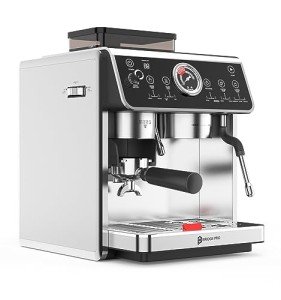Energy-Efficient Espresso Machines: A Comprehensive Guide
Worldwide of coffee enthusiasts, espresso machines are frequently related to as important devices for brewing abundant, fragrant coffee. However, the energy intake associated with these machines can lead to increased utility bills and ecological issues. As customers become more eco-conscious, energy-efficient espresso machines have actually become a popular choice. This post aims to check out the functions, benefits, and alternatives available in energy-efficient espresso machines, assisting coffee enthusiasts make notified options.
What Makes an Espresso Machine Energy-Efficient?
Energy-efficient espresso machines are designed to decrease energy usage while maintaining optimal performance. Numerous features contribute to the energy performance of these machines:
- Insulation: High-quality insulation assists retain heat, reducing the energy needed to preserve optimum developing temperatures.
- Smart Technology: Many modern machines are geared up with programmable settings that allow users to schedule brewing times and switch to standby mode when not in use.
- Quick Heat-up Time: Energy-efficient espresso machines frequently use innovative heating innovations, such as thermoblocks or PID controllers, to heat water quickly.
- Low Wattage: Machines that operate at lower wattages take in less energy in general, making them more efficient.
- Car Shut-off: Automatic shut-off includes guarantee that the machine switches off after a certain duration of inactivity, additional lowering energy waste.
Benefits of Energy-Efficient Espresso Machines
Investing in an energy-efficient espresso machine can offer several benefits:
- Cost Savings: Over time, lower energy usage can lead to minimized electrical power costs.
- Ecological Impact: Using less energy reduces carbon footprints, making these machines a more sustainable choice for environmentally mindful customers.
- Enhanced Performance: Many energy-efficient models also offer exceptional brewing technologies, resulting in better-tasting espresso.
- Toughness: Typically, energy-efficient machines are built with high-quality components, leading to higher durability.
Features to Consider
When picking an energy-efficient espresso machine, several features should be considered:
- Type of Machine: Options consist of manual, semi-automatic, and completely automatic models, each with differing degrees of user control and automation.
- Brew Quality: Look for machines that make use of high-quality brewing systems to ensure optimum flavor extraction.
- Upkeep: Some machines have self-cleaning features that can conserve energy and effort in maintenance.
- Capacity: Depending on personal or household size, machine capability can affect energy usage, with larger machines often requiring more power.
Popular Energy-Efficient Espresso Machines
The marketplace provides a variety of energy-efficient espresso machines catering to different needs and preferences. Below are some notable designs:
| Brand | Model | Key Features | Energy Consumption |
|---|---|---|---|
| Breville | Barista Express | Integrated grinder, PID temperature level control, quick heat-up. | Low |
| DeLonghi | EC155 | Compact size, simple to use, resilient build. | Moderate |
| Rancilio | Silvia | Durable design, outstanding temperature stability, and has a low ecological effect. | Moderate |
| Gaggia | Traditional | Trusted manual operation, resilient brass components, and effective steaming capability. | Low |
| Jura | E8 | Totally automatic, wise features, and a removable brew group for simple cleansing. | Low |
Tips for Optimal Energy Efficiency
Aside from selecting an energy-efficient model, customers can adopt numerous practices to maximize energy performance:
- Preheat: If your machine has a pre-heating function, use it to guarantee that the ideal temperature is reached rapidly before developing.
- Switch off After Use: Always switch off the machine after developing or use machines with vehicle shut-off features.
- Regular Maintenance: Keep the machine well-kept to guarantee it runs efficiently and effectively.
FAQs About Energy-Efficient Espresso Machines
1. Are energy-efficient espresso machines more pricey?
While the initial financial investment may be higher for energy-efficient models, the long-term cost savings on electrical power bills can offset the preliminary expense. Furthermore, Manual Espresso Machines -efficient machines come with innovative features that enhance the brewing experience.
2. How do I understand if an espresso machine is energy-efficient?
Try to find indicators such as Energy Star accreditation, user reviews, and specifications relating to wattage and heat-up time. Machines with particular functions aimed at minimizing energy intake are normally designed for better efficiency.
3. Can I use an energy-efficient espresso machine for other coffee styles?
Lots of energy-efficient espresso machines use adaptability, permitting users to brew different coffee designs beyond espresso, such as lattes and coffees, by incorporating steaming abilities.
4. Do energy-efficient models compromise quality for efficiency?
Not necessarily. Lots of energy-efficient espresso machines are equipped with high-quality brewing technology that can enhance flavor extraction while decreasing energy intake.
5. What maintenance is required for energy-efficient espresso machines?
Routine upkeep includes cleaning the machine, descaling when essential, and regularly checking seals and gaskets to ensure ideal performance and energy efficiency.
Energy-efficient espresso machines represent an ideal blend of efficiency, savings, and environmental responsibility. By thinking about different functions, benefits, and brands, customers can pick a design that fits their special preferences while contributing favorably to the environment. As the trend towards sustainable living grows, the popularity of energy-efficient appliances, consisting of espresso machines, is most likely to continue its upward trajectory, providing coffee fans a guilt-free method to enjoy their everyday dose of espresso.

